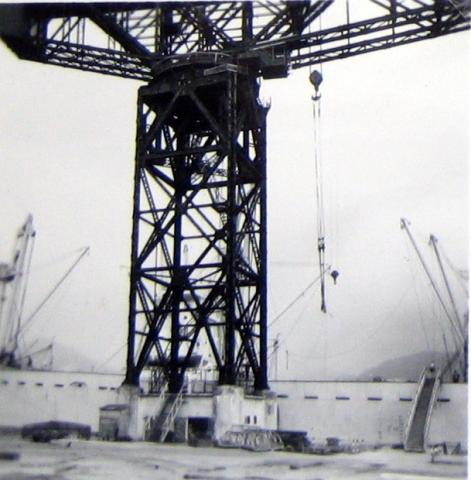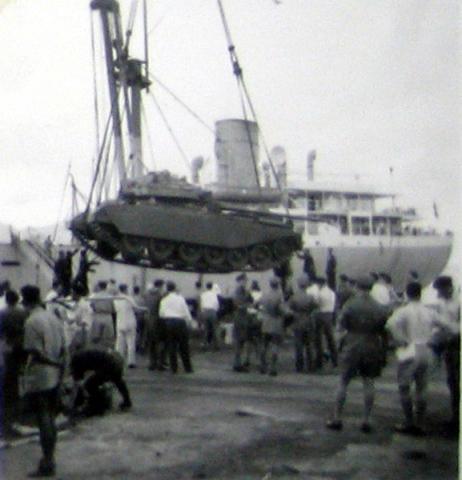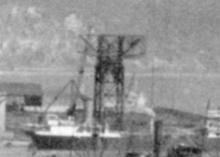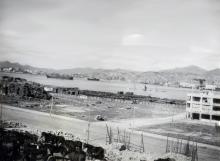This massive crane was a landmark on Hong Kong's harbour for many years, but Hong Kong wasn't its original home. The crane was built for the Earle's Shipbuilding and Engineering Co., "the largest yard building the biggest ships on the Humber in Hull" on the east coast of England.
Wikipedia explains how the crane came up for sale and was moved to Hong Kong: "[By the end of the 1920s], manufacturing in the UK was declining in the Great Depression and after Ollanta, Earle's built only three more ships. The UK government sponsored a rationalisation of the shipbuilding industry, and in 1932, the National Shipbuilders Securities (NSS) took over Earle's. NSS sold Earle's tools and machinery, shipping the yard's large crane and other equipment to Kowloon in Hong Kong."
Re-construction in Hong Kong
The first mention I've found of its re-construction in Hong Kong is in September 1936:
GIANT CRANE
Erection At Kowloon Docks
Weight Of 100 Tons
Messrs. Gammon (Malaya) Ltd. of Singapore and Hong Kong have just secured the contract for building the Reinforced Concrete Substructure for a 100 ton Giant Crane to be erected at Kowloon Docks.
The Reinforced Concrete Substructure consists essentially of four columns eight feet in diameter braced at the head by a heavy decking and with anchor beams to the shore. These Columns are carried down to the dredged sea bed 43 feet below sea level and are to be supported on four independent footings 24 feet square with 36” Vibro piles in each, going down to rock level.
Messrs. Vibro Piling Co., Ltd. Hong Kong, have recently completed successfully all the Vibro Piling work. It is interesting to note that this is perhaps the first time that Vibro Piles have been driven completely under water.
Front page of Hongkong Daily Press, 1936-09-12
The next update was in March 1937, at the Dock company's annual meeting. The foundations were nearly finished, and they expected to finish erecting the crane by the end of the year:
GIANT CRANE PLANNED
My predecessor, last year, referred to our Chief Manager's visit to Europe in general terms. While in England, In addition to calling on almost important clients, Mr. Cock purchased for us a giant crane at what has proved to be a very attractive price. The foundations of this most essential addition to our facilities are practically finished. The crane will stand in 40 feet of water at our east yard, and we hope that erection will be complete before the end of 1937.
p.5, The Hong Kong Telegraph, 1937-03-22
The following year's annual meeting confirmed the crane was complete:
Our Giant crane has passed its tests with no difficulty of any kind, and is now connected up with the Kowloon-Canton railway. The tests have been witnessed by Lloyds and other Society Surveyors and our Civil Engineer advisers, and certificates obtained from them.
p.4, The China Mail, 1938-03-28
Austin Coates also mentions the railway connection in his history of the docks:
The immediate cause for the erection of the giant crane was to facilitate the off-loading of the Kowloon-Canton Railway's steam locomotives, which were delivered direct to the docks.
p.222, "Whampoa - Ships on the Shore"
Completion date
I've guessed the crane was completed at the start of 1938, based on the notes above.
The crane during WW2
Coates again:
- Dec 1941 (p.226): [Jimmy Leitch remembers], "We had one or two visits from Japanese bombers, but no casualties. At this time demolition of some of our facilities was being carried out by a Naval team, and an attempt was made to topple our 100-ton crane."
The crane was so well installed that the explosion occurred sideways, doing scarcely any damage. It came out through the aperture in which it had been inserted. - Jan 1945 (p.229), Coates notes the American air raid on the docks, made by planes flying from American aircraft carriers.
- Late 1945 after the Japanese surrender (p.233): The tip of the giant crane was damaged, and its main girders distorted, though if this was rectified it could be used, provided the sunken ship in front of it could be moved.
The vessel lying alongside the 100-ton crane was the Mansan Maru. She had been hit by two bombs, evidently block-busters, since the ship appeared to be almost broken in two. Captain W.A. Doust, the Admiralty's salvage expert responsible for clearing the harbour, examined the crane foundations, and found them to be undamaged. If the bombs had landed 30 feet closer, the crane would have been destroyed.
Post-war
The crane was soon back in use again. These photos from the 1950s show it being used to unload Centurion tanks that had fought in Korea, and were now to be based in Hong Kong:
Retirement and demolition
Does anyone know when the crane was used for the last time, and when it was finally demolished? [Update: demolished in mid-1982, see comments below.]






Comments
Hammerhead Crane (Demolition) Timeline
It's not easy to find the demolition date of the Hammerhead Crane, Hung Hom. Fortunately, in the early 1980s frequent aerial survey flights were performed that are accessible at the website of HKMS 2.0. These were executed at different flight altitudes, therefore some photos have poor resolution.
In this compilation the top row shows the crane, while it's already gone at the bottom row. So the demolition date should be between May and October 1982.
re: Hammerhead Crane (Demolition) Timeline
Thanks Klaus, I've set the demolition date to mid-1982.